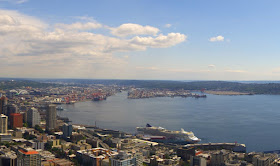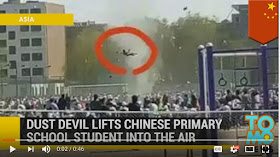On Sunday around 3:50 PM, a "whirlwind" struck the Highland Park playground of West Seattle (see West Seattle Blog feature below).
A scene of disarray and disorder ensured. Wood chips were lifted and swirled into the air, some of which embedded in the clothes of parents and children. Picnic makings were thrown about. Blankets and clothes were blown into the air. A kite was lofted and never seen again. Reminiscent of scenes from Sharknado3.
There is little doubt that a phenomenon known as a dust devil hit Highland Park that afternoon, on an otherwise sunny day with only a few cumulus clouds. No tornado, since that the feature is associated with tall cumulonimbus clouds.
Dust devils are not rare phenomena, often seen in desert and arid climates. They are associated with rotating thermals of upward moving air, with winds that can reach 30-50 mph over a very limited area (usually the diameter of the devil is 5-10 feet).
Thermals are generally associated with unstable conditions at low levels characterized by a large change in temperature with height (a large lapse rate). When the vertical temperature change gets large enough, the atmosphere begins to convect, with upward and downward motion. Similar to your hot cereal convecting when the saucepan is heated from below. A schematic is shown below:
As shown in the map below, Highland Park is on the "plateau" of the West Seattle uplands.
It is a large park with an extended open/grassy area that has a good exposure to the sun.
As reported by park goers and confirmed by the Space Needle Cam at 3:50 PM, there were a few cumulus clouds over the park at the time: a sign of an unstable atmosphere with upward moving thermals (that is what produces the cumulus clouds).
Where does the rotation come from? One source is the vertical wind shear (change of wind with height). Such wind shear can produce rotation around a horizontal axis (see figure), which can be realigned into the vertical by upward motion. Obstacles can also induce rotation about a vertical axis.
As noted earlier, West Seattle has a history of whirlwinds hitting gatherings of children. For example, inn 2001 what was apparently a weak tornado hit Gatewood Elementary School, lifting a few kids into the air. Fortunately, teachers had firm grasp on each child and none flew as high as the Chinese child above.
Parents are well advised to hold on to their kids when visiting West Seattle parks and playgrounds. Because of the persistent whirlwind threat in the area, a number of West Seattle parents, concerned with their kids well being, have turned to safety devices recommended by the National Weather Service, as part of the KidSafe Program of the WeatherReadyNation effort.
Approved by the National Weather Service
According to leading climate scientists, because of the profound surface heating associated with human-caused global warming, we can expect such incidents to increase in the future.











I think you shifted too quick from incisive analysis to humor! Careless readers may miss that the last two references are tongue-in-cheek :)
ReplyDeleteCliff,
ReplyDeleteCan you write a post about why our summer sucks this year? Is it the position and strength of the north pacific high? Something else going on? How long until summer starts (if ever) this year?
Something that has always confused me: gliders get extra lift from the rising hot air in thermals, yet in general planes find it harder to take off in very hot air, because it's less dense. Is there more lift from hot air at high altitudes then near the ground?
ReplyDelete-Douglas
Sucks...??? We've got the only good weather in the US this summer.
ReplyDeleteWell, unless you like 100F at near 100%RH under the heat dome. A lot of people are suffering out there.
As a Kansas resident (for the geographically challenged, Kansas is located roughly in the center of "fly-over country"), I have only recently become aware of your blog. Have you ever presented an analysis of the effect on global warming of vitriolic spewing in social media? There is certainly plenty of hot air out there...
ReplyDeleteUnknown: Why is this summer an issue? The last two summers were so uncomfortably hot, especially last years. So far this summer has been great, and don't worry, there will be some typical heat next week, though not as much as the center of the US (It seems the midwest is getting the heat patterns we got in the PACNW last year, this year). Though I have read another downturn in temps after the 3rd of August, but I am sure there will be many more nice days ahead. However, we are just about at years peak, by daily average, for temps; normally in the last week of July, so it might turn out to be a cooler summer in general, but that is not a bad thing. Could be a result of El Nino being so hot and dying out fast, not sure.
ReplyDeleteNice rain today, Cliff. Thanks!
ReplyDelete